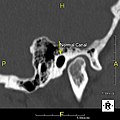Surfer's ear
| Surfer's ear | |
|---|---|
ENT surgery |
Surfer's ear is the common name for an
Irritation from cold wind and water exposure causes the bone surrounding the ear canal to develop lumps of new bony growth which constrict the ear canal. Where the ear canal is actually blocked by this condition, water and wax can become trapped and give rise to infection. The condition is so named due to its high prevalence among cold water surfers, although it can occur in any water temperature due to the evaporative cooling caused by wind and the presence of water in the ear canal.
Most avid surfers have at least some mild bone growths, causing little to no problems.
Signs and symptoms
In general, one ear will be somewhat worse than the other due to the prevailing wind direction of the area surfed[3] or the side that most often strikes the wave first. Common symptoms include recurrent otitis externa, obstructed sensation, conductive hearing loss, pain in the ear, and tinnitus.[1]
-
Normal ear canal
-
Normal ear canal
-
Exostosis in ear canal
-
Exostosis in ear canal
Causes
The majority of patients present in their mid-30s to late 40s. This is likely due to a combination of the slow growth of the bone and the decreased participation in activities associated with surfer's ear past the 30s. However, surfer's ear is possible at any age and is directly proportional to the amount of time spent in cold, wet, windy weather without adequate protection.[4]
The normal ear canal is approximately 7 mm in diameter and has a volume of approximately 0.8 ml (approximately one-sixth of a teaspoon).[5] As the condition progresses, the diameter narrows and can even close completely if untreated, although people generally seek help once the passage has constricted to 0.5–2 mm due to the noticeable hearing impairment. While not necessarily harmful in and of itself, constriction of the ear canal from these growths can trap debris, leading to painful and difficult to treat infections.
Prevalence
A 2015 review of eight other studies found the prevalence ranged from 31% to 80%, largely depending on sea temperature of the geographical area studied, with colder climates having higher prevalence.[6][7] The study also found among 105 surfers in Cornwall, England 63.8% had surfer's ear.[6]
Prevention
The widespread use of wetsuits has allowed people to surf in much colder waters, which has increased the incidence and severity of surfer's ear for people who do not properly protect their ears.
Treatment
Outside of symptom relief, the only treatment is surgical removal of the formed exostoses.[9] Although not an especially hazardous surgery, exostosis removal can result in major complications such as facial nerve paralysis, canal stenosis, temporomandibular joint prolapse, hearing loss, persistent deep bony lip, and persistent eardrum perforations.[9]
Surgical techniques include drilling the bone off and later cleaning debris using a osteotome, typically under local anesthesia or general anesthesia with the use of a microscope.[10][11][12] After surgery it is recommended to continue keeping the ear clear of water, and for one study using ciprofloxacin/hydrocortisone drops were recommended for one week post-surgery to avoid infection, and 90% of the study group had fully healed after four weeks.[10]
Archeology
Archeological research in Gran Canaria, Spain, has found a relatively high prevalence of exostosis among Pre-Hispanic craniums, reaching 34.35% in coastal burial places. Not all coastal craniums presented exostosis but there were no differences between sexes. Researchers thus proposed a social
See also
- Surfer's myelopathy – A spinal cord injury caused by hyperextension of the back
- Pterygium (conjunctiva)– Pinkish, triangular tissue growth on the cornea of the eye
References
- ^ S2CID 9779392– via Wiley.
- S2CID 7000061.
- S2CID 205754007.
- ^ S2CID 25348240.
- ^ Ojala K, Sorri M, Sipila P, Vainio-Mattila J. Correlation of postoperative ear canal volumes with obliteration material and with volume of operation cavity.Arch Otorhinolaryngol 1982; 234: 37-43.
- ^ S2CID 24686677.
- S2CID 25348240.
- ^ S2CID 19612199.
- ^ S2CID 25348240.
- ^ S2CID 42371615.
- ^ Hetzler, MD, Douglas. "Relief for Surfer's Ear". Palo Alto Medical Foundation.
- S2CID 23553829.
- ^ "Exostosis auricular - El Museo Canario - Reportajes". Revista 7iM (in Spanish). 21 December 2018. Retrieved 8 September 2023.




